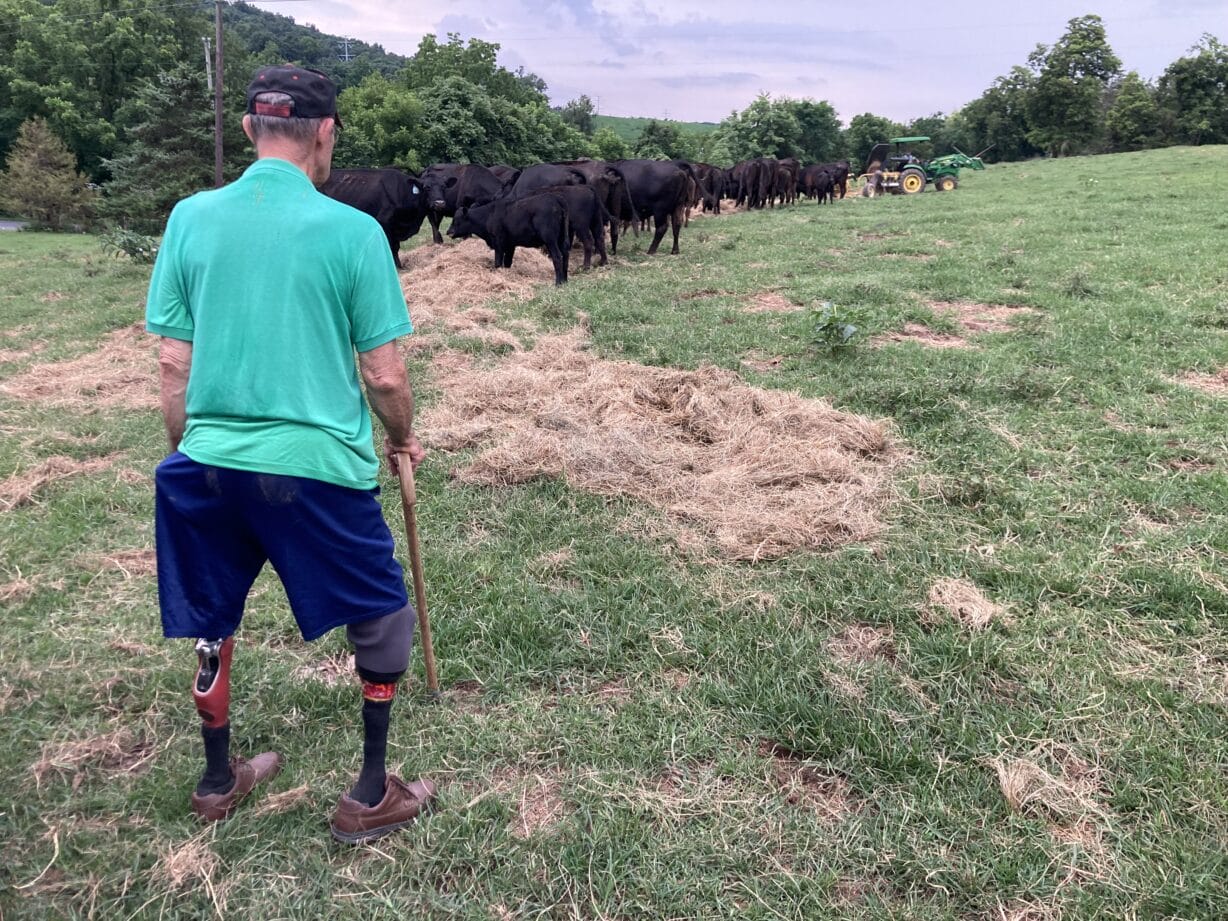
Story and photos by Mike Grundmann, contributor
At the Rockingham County Fairgrounds, an audience of schoolkids watches as a “farmer” made of straw and coveralls gets too close to some fast-spinning farm machinery. The machine instantly sucks it in and shreds it.
Art Mitchell, a Keezletown farmer, tells the students, “It can happen in one second.”
Then he lifts up his pantlegs to reveal two prosthetic limbs.
It happened to him.
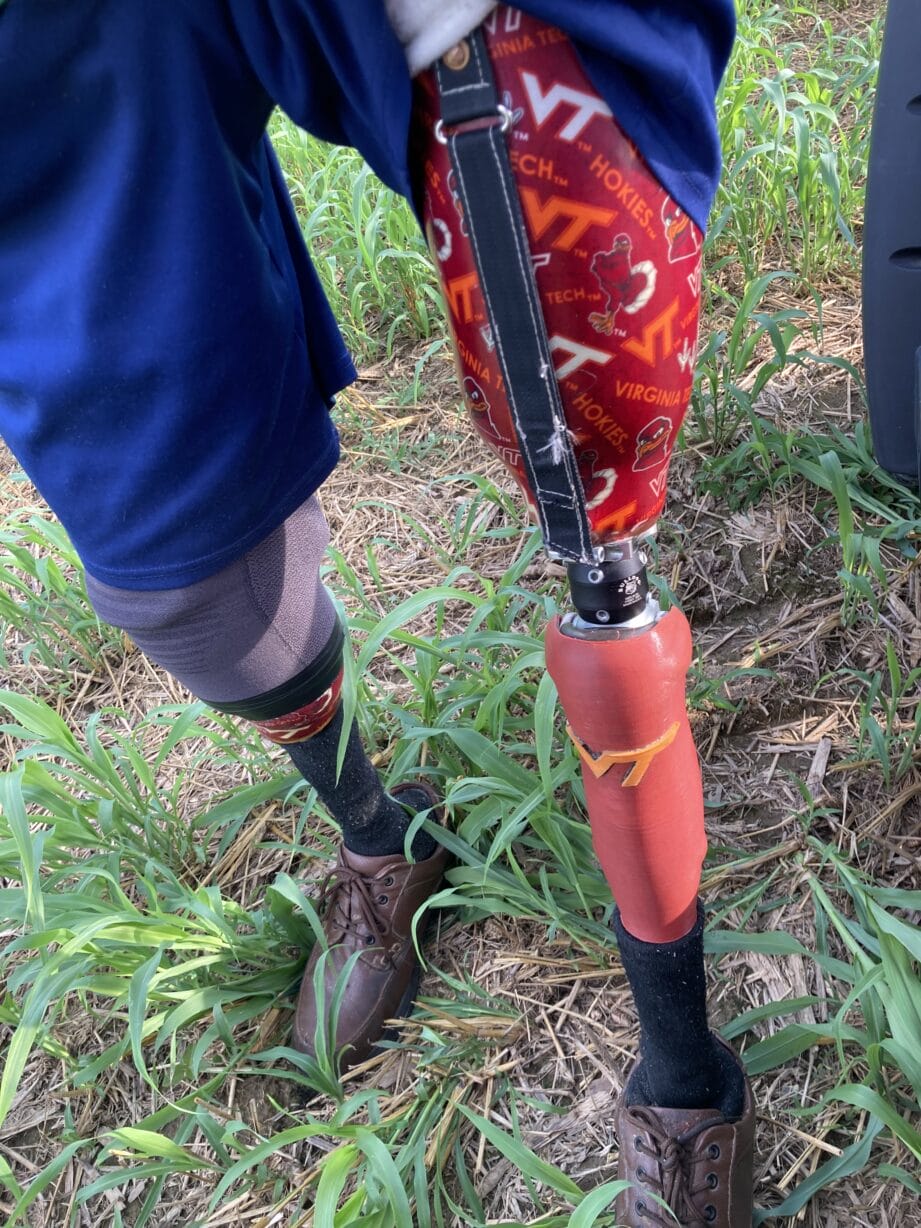
It was 1978, when he and his wife, Mary Jo, were full-time school teachers and full-time farmers.
He lost one leg above the knee and the other below the knee. He wasn’t expected to survive.
That was 47 years ago. He still farms today at age 87, and driving the tractor is where he feels “right at home.” His prosthetics are emblazoned with the logo and mascot of Virginia Tech, his alma mater. He has an easy manner, likes to joke and peppers his conversation with “yessir.”
Locust Rock Farm is about 100 acres, where he grows hay and about 70 head of beef cattle with help from Galen Armentrout, who lives a mile away and started when he was one of Art’s 7th-grade students.
“He’s pretty determined to do a lot of stuff,” said Armentrout, who is also a mechanic at James River Equipment in Harrisonburg. “He would fall once in a while, with the uneven ground. He does not want to fall.”
“I do as much work as I can,” Art said. “I’m still 100% involved.”
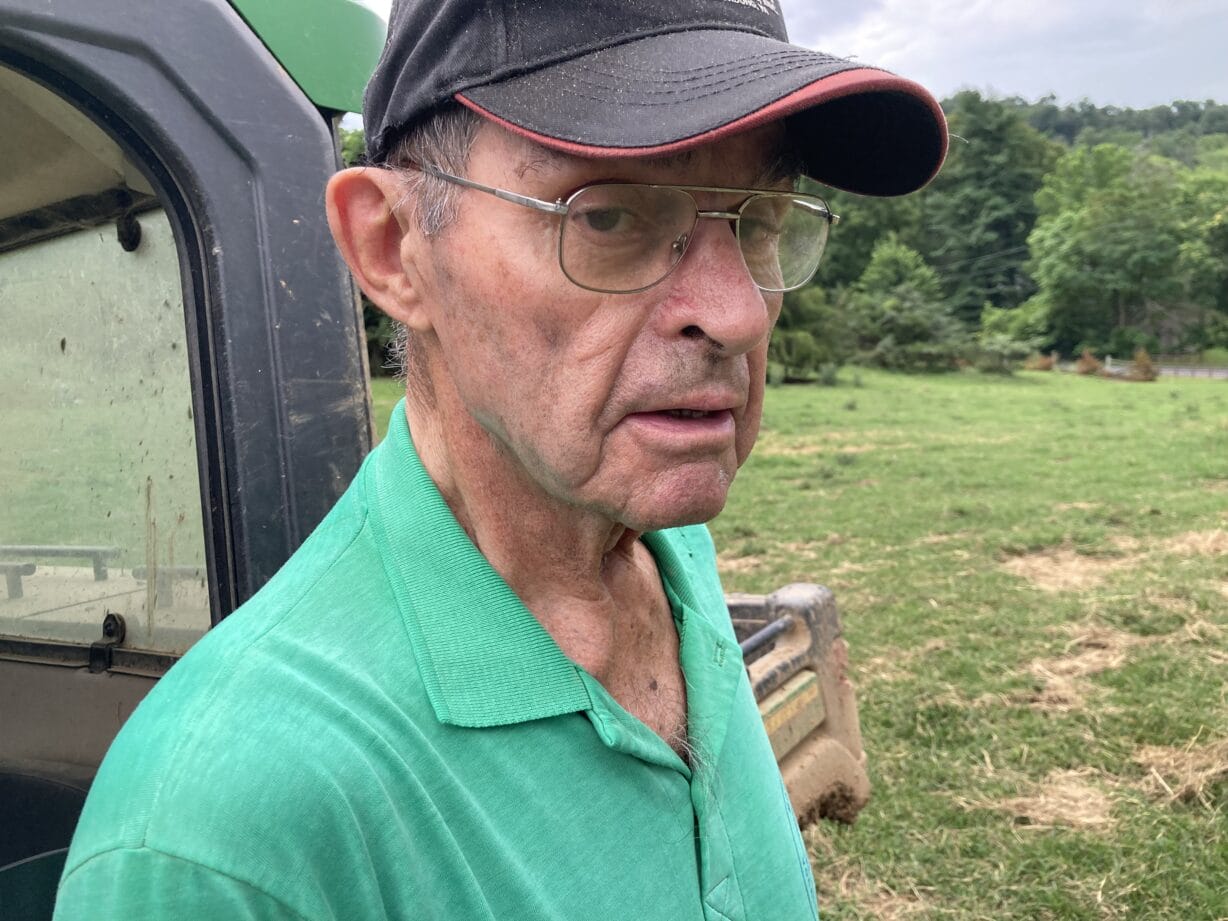
None of Art’s farm or personal vehicles have added hand controls. He relies on automatic transmission, so there’s no clutch to bother with.
“Art’s one of a kind,” said Kevin King, his certified prosthetist. “He’s very strong, determined. He has a good attitude about what he needs to do to stay mobile. … I don’t know a lot of 87-year-old farmers who make hay and feed cattle.” Prosthetics, formed by 3-D printing and covered by Medicare in Art’s case, can run $10,000 for below-knee to $80,000 for above-knee with microprocessor control.
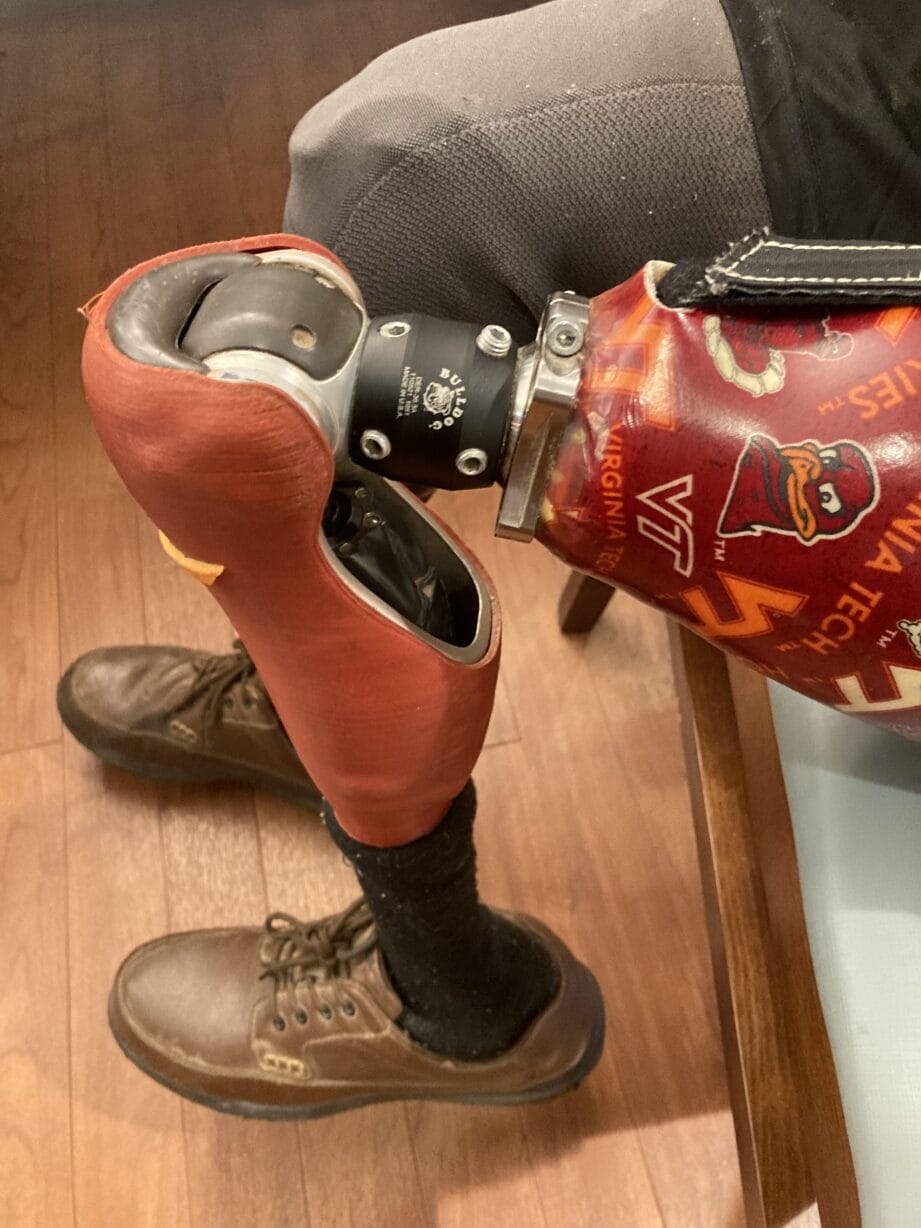
Five or six years ago, Art had a stubborn bone infection on his right leg that, despite his claustrophobia, put him in a pressurized hyperbaric chamber feeding pure oxygen to his tissues and bloodstream. He had 40 treatments of three hours each, five days a week. Then surgery followed. He had spent more than a month unable to wear his prosthetic.
He’s been doing the farm safety demonstrations at schools and the fairgrounds for more than 20 years. One student said Art’s accident “must be the worst thing that ever happened to you.” Art’s reply was, “No, the worst thing was what it put my wife through.”
On Aug. 2 this year, they mark their 66th wedding anniversary.
Art was raised on a farm in Mount Solon, when hay was handled with a pitchfork. He and Mary Jo met as freshmen at North River High School near Bridgewater and started dating by senior year. They married and became teachers at area schools. Art taught agriculture and shop and was FFA adviser, for a total of 47 years. Mary Jo taught business for 35.
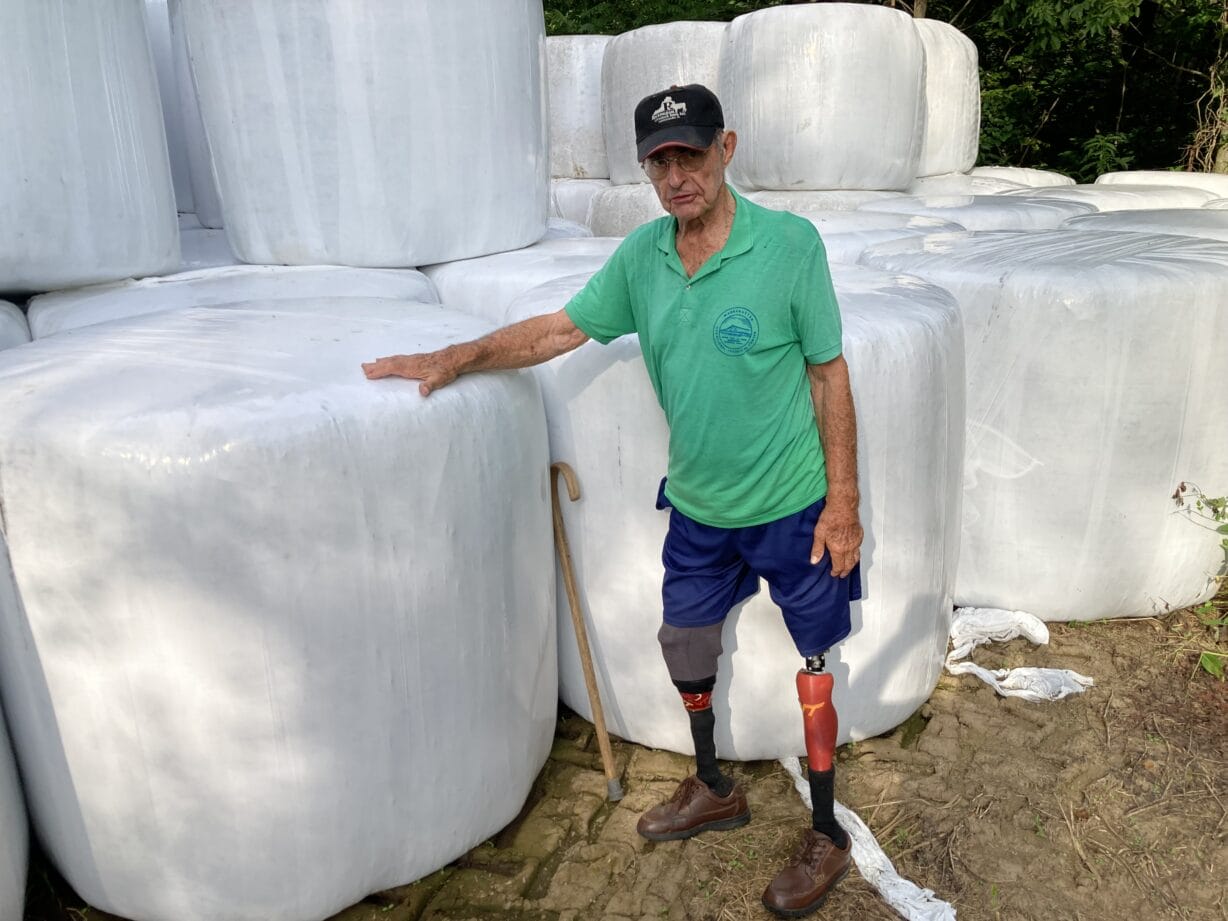
On Oct. 23, 1978, Art fired up a picking machine to finish the corn harvest.
Cattle had trampled some of the corn and the gathering chain was set low, partly hidden in the foliage. He planted his foot too close and the chain dragged him in. He couldn’t shake his boot off.
“I prayed: ‘Lord, I’m in trouble. I need help.’ “
A neighbor boy who had offered to help with the harvest noticed Art’s tractor wasn’t moving and came to check on him. Instantly understanding the situation, he turned the machine off.
“We rushed out east of town with sirens and lights,” said Gene Harper, who at the time was a general surgeon at Rockingham Memorial Hospital. “Art’s survival was severely in question because of the amount of time he’d been in the machine, having lost most of his blood volume.” One leg was completely detached and the other was hanging by a bit of skin and some clothing. Using a small pocket knife, Harper freed it.
“The cardiac arrest occurred about four or five blocks from the hospital,” Harper said. “Then we had to do CPR. We were able to order a blood transfusion, to get more IV fluids started, put in a tracheal tube and start ventilation.”
“Then they got him right off to surgery,” Mary Jo said.
“I think,” said Harper, “the fact that it was, in a way, a clean cut, sort of a pinching cut, saved a lot of blood, bought him some time.”
“I’m told,” Mary Jo said, “that there were college students with books in arm lining up to give blood. I’m told that a tractor-trailer driver going on 81 veered off the highway and donated blood.”
“Totally, Art used 114 units of blood,” said Irvin Hess, who was one four orthopedic surgeons to take the case. “It’s unusual for anyone to survive who used over 80 units.”
Mary Jo said, “He had surgery or a surgical procedure every other day, and that was good in a way because of the stench in the room of dead or dying tissue. … He was knocking hard on death’s door.”
“I woke up, looked at my leg” said Art. “It looked like a ham hock. I said, ‘Lord, look, you made a mess outa me.’ And it seemed like the prayer got turned around: ‘OK, Lord, be your will that I live, make the best out of it.’ “
“Of the 98 days he was in the hospital,” said Mary Jo, “I ended up being there 97 days. But I am very, very thankful for the family and neighbors and everybody, particularly who took over our livestock. It was humbling.”
“Halfway through his hospitalization,” said Hess, “he bled when no one expected him to bleed, and had actually gone into shock. … I left my house and got to Art’s bedside in about 13 minutes. I drove on the interstate at 103 miles an hour. I couldn’t drive my Mercury any faster because it started to shimmy.”
Laddie, their sable Collie, acted distraught at Art’s absence. He wouldn’t eat and at one point disappeared apparently to hunt for him.
“I was real worried about Art,” Hess said. “I talked to the people at the hospital. They wouldn’t let me bring Laddie in.”
So the reunion took place in the hospital basement.
“Arthur got into a wheelchair, IV pole and all,” Mary Jo said. “Dr. Hess angled him in to the sofa so the dog couldn’t pounce on his legs, and the dog very tenderly put his front paws on the arm of the wheelchair and licked Arthur on the jaw. Then he went around on the other side of the wheelchair and did the same.”
“There’s a faith element to this,” said Hess. “Having faith and a will can get you a long way in medicine.”
“Evidently, I’m able to withstand pain quite well,” Art said. “On a scale of 1 to 10, I guess it would be an 8 or 9.”
“One night.” Mary Jo said, “after he got home from the hospital, he awakened me and he was sitting in the middle of the bed, laughing. I said, ‘What is wrong?’ He said, ‘Well, my foot was itching and I was trying to find my foot.’ “
“The big question is, how did I survive?” Art said. “My wife’s care, the doctors’ concern, the nurses, neighbors, friends, also the power of prayer, the church and ministers, all that put together.
“I did go back to teaching full time,” Art said. “I really missed those students because I’ve always had a home in the classroom. There wasn’t a student I couldn’t work with.”
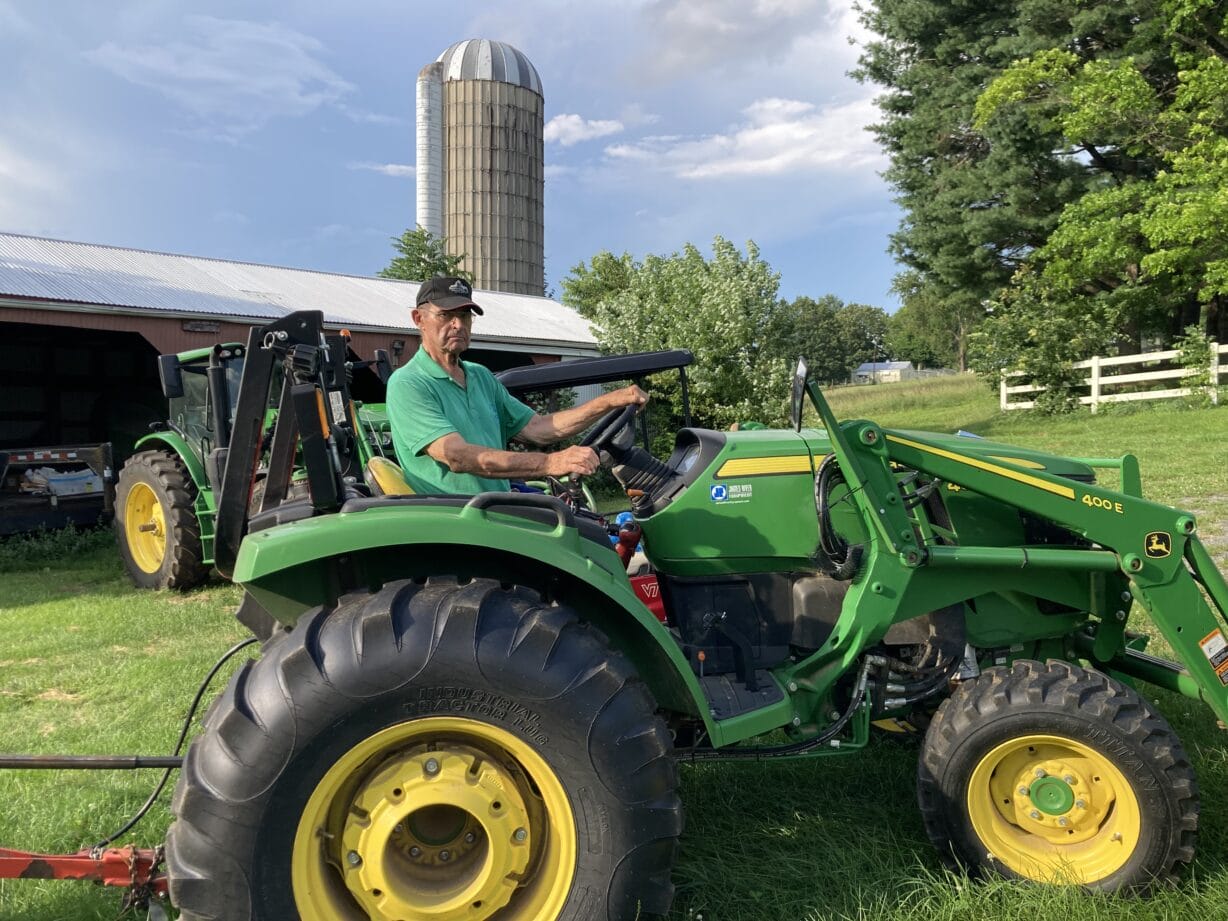
Eighteen years later, Feb. 11, 1996, Art was driving home on a tractor with a stalling problem.
“The train tracks were approximately 200 yards from my house. As I approached the track, I said, ‘I’m gonna be sure there’s nothing coming.’ It just stopped. It wouldn’t start at all. I tried to rock it. Wouldn’t move. The train seems to come around the curve pretty quickly. I said, ‘Get outa this tractor.’ Then I got to thinking, with two artificial limbs, they might get tangled, might trip, fall on the tracks, a sure death. So I elected to ride it out.”
“I was at the top of the hill in our yard,” Mary Jo said. “I heard the train dispelling air brakes and I knew he was on the way home. I thought to myself, I hope I’m not gonna see what I think I’m gonna see. Here’s the tractor wrapped around the front of the train. It pushed him down the tracks about 200 yards. … Arthur had a laceration on his forehead and a concussion. [The train] wasn’t going 60 miles an hour, that’s for sure. Of course, there was broken glass in the tractor. He had glass even on his eyelid.”
“I woke up,” Art said. “I’m lying on this X-ray machine … I looked around to the left and saw ‘RMH, Rockingham Memorial Hospital.’ … Here come these doctors and my wife, and I say to her, ‘What am I doing in here?’ She said, ‘Well, you got hit by a train.’ I said, ‘Well, that sounds kinda bad.’ “
Editor’s note: Portions of this story were taken from a 2012 documentary by Mike Grundmann about Art Mitchell and his ordeal.
Mike Grundmann is a retired JMU journalism professor who previously worked as a reporter and editor for eight California newspapers, including the Los Angeles Times. He has produced 10 award-winning documentaries.
Thanks for reading The Citizen, which won the Virginia Press Association’s 2022 News Sweepstakes award as the top online news site in Virginia. We’re independent. We’re local. We pay our contributors, and the money you give goes directly to the reporting. No overhead. No printing costs. Just facts, stories and context. We value your support.












